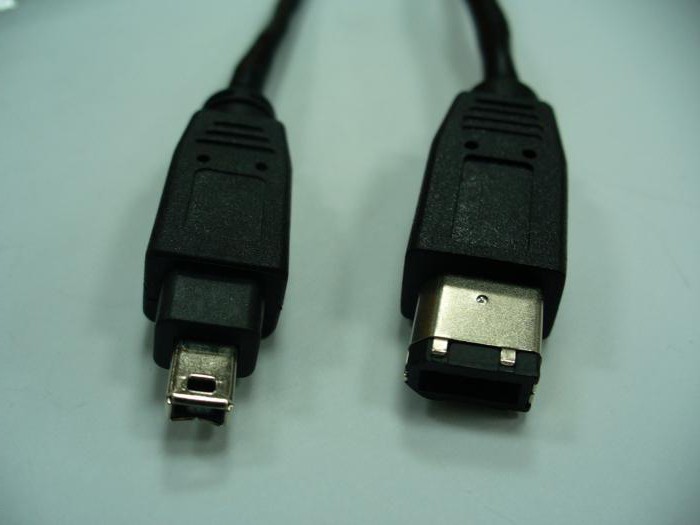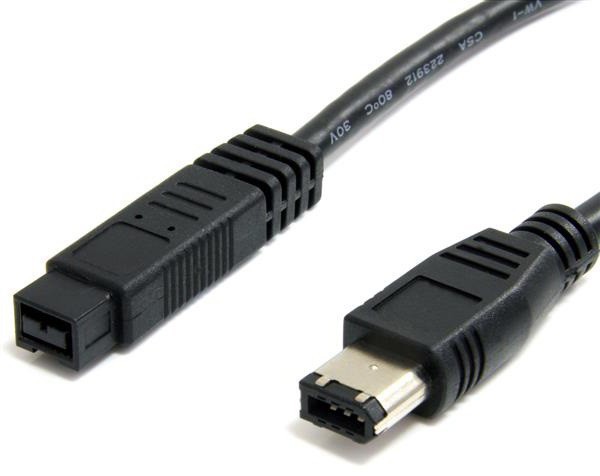IEEE-1394 (also called FireWire) is a high-speed digital serial interface designed to transmit any digital data. Today it is actively used in a variety of devices, including not only PCs, but also many mobile gadgets.
Where is it used?
The development of IEEE-1394 was carried out in order to provide users with high-speed access to various storage devices, including hard drives, as well as CD and DVD drives. At the same time, it was planned to make such an interface that would be truly universal, and then use it in various input devices, including scanners, photo or video cameras, as well as other audiovisual equipment. But at the same time, its excellent parameters, such as flexibility and utmost ease of use, together with the ability to prioritize when transmitting information that needs time synchronization as a critical factor, were ultimately considered optimal for ensuring normal digital video transmission, as a result, to this day there is no alternative to them. The first hardware solution that used the IEEE-1394 interface was all kinds of boards designed to work with digital video.
What does he give?
This standard allows you to combine software and hardware in order to transmit information in a stream of 100, 200 or 400 Mbit / s, while the latest implementations provide an even higher transfer rate. The communication between several devices with the IEEE-1394 interface is activated and deactivated directly during operation (which is called "hot connection"). In other words, they do not need to turn off the power or reboot.
Sony and its development
For the first time, Sony began to use the advantages of IEEE-1394 in its development, paying attention to scalability, speed of information transfer, the possibility of real-time data processing, ease of connection, and at the same time a rather small cost. As a result of this, the development of specialized integrated circuits sharpened for this standard has begun.
After the release of their digital video cameras , Sony specialists began to develop a variety of solutions designed for personal computers, digital satellite TV receivers, digital video recorders, as well as various hard drives and CD or DVD drives. All these devices significantly expand the general possibilities of connecting various video or audio equipment to computers, as a result of which there is an opportunity to create a full-fledged home audio-visual network.
How can this be used?
Already today, you can freely integrate a variety of equipment with a computer, thus ensuring the effective management of any devices directly from your PC. Entire equipment can be formed from this equipment, united by a standard connection of several devices with each other using a cable. Then, using a personal computer that acts as a controller in this case, you can record from a CD player to small mini-disks, record digital radio broadcasts, and also enter any video files into a PC, so that you can later mount and edit them. Of course, this will preserve the possibility of a direct exchange between video and audio equipment without the need for a computer or, on the contrary, the exchange of information between several computers in the same way as in local networks based on standard Ethernet technologies.
NEC and its chip
Almost immediately after the release of the IEEE-1394 standard, NEC Corporation announced that it was developing a chip that would be used to support hardware routing between several networks based on this standard, as well as ensuring their normal interaction in broadband home networks of this standard. Such a two-port chip was equipped with specialized firmware software that automatically configures the network, as well as providing the ability to establish connections between various network devices, including mobile communication devices. In this regard, there is the possibility of expanding the home network beyond the borders of a particular house to a distance of up to one kilometer.
Answer from Sony
At this time, Sony continued to develop the concept of a home network based on the FireWire IEEE-1394, while the immediate plans of the company also included further support for development of practical orientation, as well as going to produce faster, more capacious, as well as compact components with low energy consumption. Such devices will have to have a wide enough range of applications, as well as further integration into system chipsets, and the company has long been providing its customers with a wide variety of household appliances that connect to a home network. This architecture is called HAVi, creating a kind of digital home based on the FireWire IEEE-1394.
Standard in computers
The IEEE-1394 standard, the photo of the cable with which you can see below, has attracted attention not only from manufacturers of various media equipment, but also from developers involved in the manufacture of devices for personal computers. Over time, it has become the main network standard, which significantly brought the digital age closer.

After the release of the Windows Millennium operating system, the developers initially approved the support of local networks based on IEEE-1394 controllers, the characteristics of which at that time were more than appropriate. Such a network is characterized by a sufficiently high data transfer rate, which was four times higher than that used at that time in comparison with Fast Ethernet, and is also extremely convenient for a small office or home. The only convenience in the process of building this network is that there is a small limit length of each segment. In order to eliminate this drawback of IEEE-1394, a review and characteristics of the device showed that it would be most optimal to use specialized signal amplifiers, as well as all kinds of multiplier hubs operating on several ports. Such devices are called “repeaters”.
USB 2.0 vs IEEE-1394
Almost immediately, the released USB 2.0 interface began to compete with IEEE-1394. A review of devices showed that the data transfer of the first interface showed 480 Mbps at that time, which was much more compared to the first version of USB.
The USB bus immediately became quite popular, due to the fact that it was a fairly cheap option with controller support, which can be integrated directly into the chipsets for various motherboards. At the same time, it was almost immediately announced that the high-speed format could be implemented as a controller built into the chipset. Despite all this, Microsoft said that it is IEEE-1394 (port) that is more priority for it, while USB is distinguished by asynchronous transmission, as a result of which it cannot compete with the FireWire format in terms of digital video transmission.
In other words, any devices using this interface can perfectly interact with various personal computers having such an interface, as well as between themselves. Thus, users have the opportunity to transfer, process and store information at high speed without causing any quality degradation.
Controllers
On sale there were a lot of controllers issued by a variety of manufacturers. Initially, controllers supporting the OHCI standard were widely used, as it was necessary to ensure normal support for the Windows 2000 operating system, which was the main one at that time.
The prices of various adapters supporting the IEEE-1394 interface were quite low and were available to almost everyone. In particular, there were devices whose cost is below 35. $
Is it difficult to install?
Installing this controller was extremely simple, because, as mentioned above, Microsoft initially provided support for this particular interface, and therefore all necessary components were present in the operating system. It was enough just to insert a disk with the system distribution recorded on it, and then, if necessary, install all the necessary components.
In the predominant majority of cases, the FireWire controller shared the interrupt with the USB controller, but there were no conflicts even if they worked simultaneously.
It is worth noting several boards that are present on some computers even to this day.
Datavision dv capture
This board is standard for the IEEE-1394 family of boards, the scope of which is wide enough. In the predominant majority of cases, it is a PCI-card with two or even three additional external ports, as well as one internal. The initial delivery provides faceless software designed for editing video files. Such boards were used by many manufacturers, but they were all the same. Their prices are different, and in the kit there may or may not be a cable designed to connect various FireWire devices.
DVeasy
This board is almost the same as the previous one, but in this case there are no internal ports of IEEE-1394. What few people understood what it is, because there are a lot of reasons that make it necessary to have at least one internal port, but the manufacturers of these cards calculated differently, and the cost of the board was set exactly the same as in standard devices.
The difference between this board among the rest is that it contains quite unconventional software designed for video editing, and its interface is more similar to the actual standard in this area. In particular, it is worth noting that this software provided a variety of useful elements, including background rendering, which helps to “brighten up” the expectation of the final result.
Dazzle DV-Elitor
After the speed of data processing by laptops was almost equal to the speed of personal computers, various portable solutions began to be used more and more often in order to provide input and further editing of video on the go, as well as to use many other FireWire peripherals. Such kits provide the ability for laptop users to connect absolutely any device using the IEEE-1394 standard to a PCMCIA Type II card. The standard set of this card contains a specialized four-wire cable. Unfortunately, there are a fairly large number of devices with this interface for which you need to use a six-wire cable, as a result of which they will not be able to work with this card.

In the package there is a simplified version of Video Studio 4, which is designed to edit and enter video files. The program is quite simple to learn, but thanks to the specialized SmartRender technology, the overall operating time is significantly reduced, which is ensured by an extremely detailed calculation of the effects only during the final export of a finished file.
The card is quite affordable in terms of cost to most modern users, and is also equipped with an integrated cable. However, it is worth noting that the lack of power seriously limits the functionality of this card compared to similar devices.
Thus, users have the opportunity to choose one of several cards, compare their characteristics and decide which option is most suitable for their conditions. But in general, its use is not so relevant with existing interfaces USB 3.0 and others.